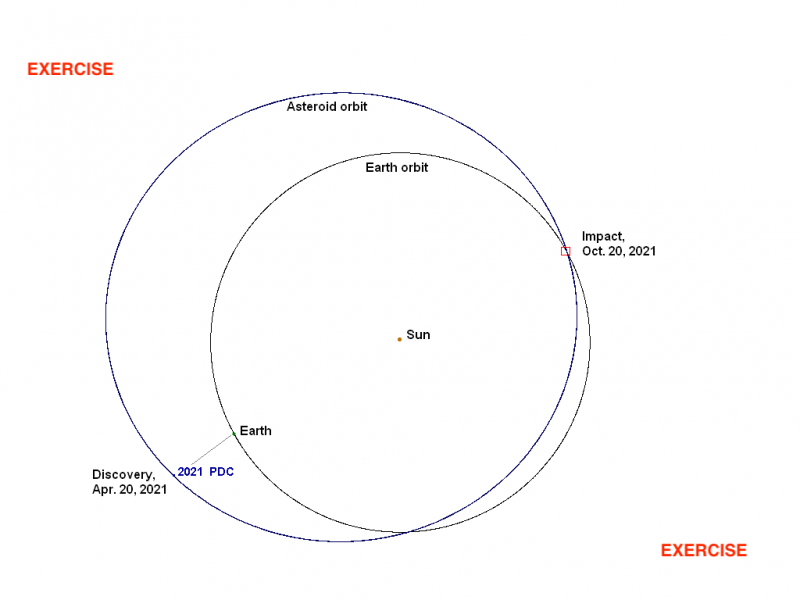
ESA said today (April 26, 2021) that it’ll be live-tweeting the asteroid impact exercise unfolding now at this week’s Planetary Defense Conference, which is held virtually April 26 through 30. ESA social media, particularly @esaoperations on Twitter, will be following the action, and you can also follow via ESA’s blog on the subject. It looks as if NASA’s Planetary Defense Coordination Office (@AsteroidWatch) will also be following the action, and no doubt many others will be as well. This is the 7th of these conferences, which are held every two years, and it’s the second time ESA has live tweeted the conference’s primary exercise – a drill, if you will, simulating an asteroid impact about to happen – as it is unfolding during the conference. Scientists, space agencies and civil protection organizations aren’t using a real asteroid for this exercise, but instead have made one up of whole cloth, calling it 2021 PDC (which stands for 2021 Planetary Defence Conference). Throughout this week, this group of international asteroid experts will be pretending this fictional asteroid is about to strike Earth (it isn’t). They’re just practicing, should a real asteroid impact ever be imminent.
Here in the U.S., scientists at the Center for Near Earth Object Studies in Pasadena, California have compiled the exercise’s basic info – for each day of this week – which you can also follow here, beginning with these (fictional) statements:
An asteroid is discovered on April 19, 2021, at apparent magnitude 21.5, and confirmed the following day. It is assigned the designation “2021 PDC” by the Minor Planet Center. (To reinforce the fact that this is not a real asteroid, we are using three letters in the designation, something that would never be done for an actual asteroid.)
The day after 2021 PDC is discovered, JPL’s Sentry impact monitoring system, as well as ESA’s similar CLOMON system, both identify several future dates when this asteroid could potentially impact the Earth. Both systems agree that the most likely potential impact occurs on October 20, 2021 – just 6 months away – but the probability of that impact is low, about 1 chance in 2500. With only two days of tracking on this object, no better estimate of impact probability can be made.
Very little is known about the physical properties of 2021 PDC. Its size, in particular, is highly uncertain. Based on its mean apparent visual magnitude, the asteroid’s absolute (intrinsic) magnitude is estimated to be H = 22.4 +/- 0.3. If 2021 PDC’s albedo (reflectivity) is 13%, a typical mean value, this H value implies a mean asteroid size of about 120 meters. But the true albedo is not known and the asteroid’s size could therefore range anywhere from as small as 35 meters to as large as 700 meters.
Follow ESA’s tweets about the asteroid impact exercise here.
Follow NASA’s tweets about the asteroid impact exercise here.
This week, experts are meeting at the #PlanetaryDefense Conference for a pretend asteroid impact. Why? So, in the unlikely event it does happen, we'll be ready.??
We'll be live-tweeting the #fictionalimpact of asteroid #2021PDC
Daily updates?https://t.co/B1X0ifk52B#SpaceCare pic.twitter.com/5dAG6DQVuZ— ESA Operations (@esaoperations) April 26, 2021
Starting 4/26, members of @NASA's #PlanetaryDefense Coordination Office will participate in a hypothetical #asteroid impact “tabletop” exercise, led by @NASAJPL, that will take place during the 7th IAA #PlanetaryDefense Conference.
Learn more: https://t.co/nPIOIlKAEA
— NASA Asteroid Watch (@AsteroidWatch) April 21, 2021

Bottom line: Asteroid scientists, space agencies and civil protection organizations will be participating in a drill – simulating an asteroid impact about to happen – during this week’s Planetary Defense Conference, which is being conducted virtually.











